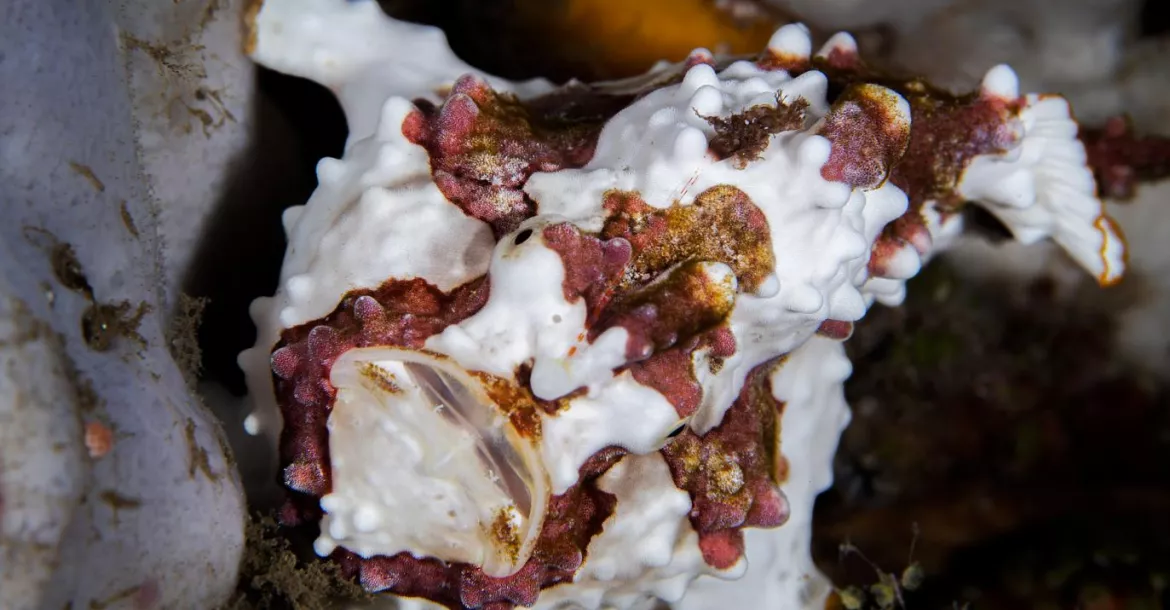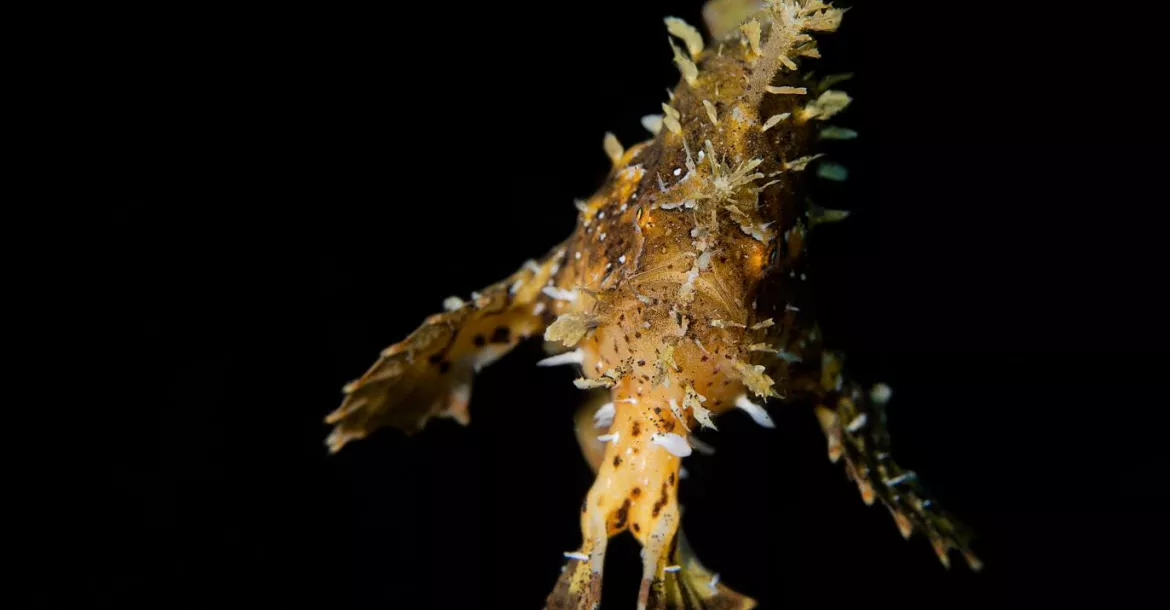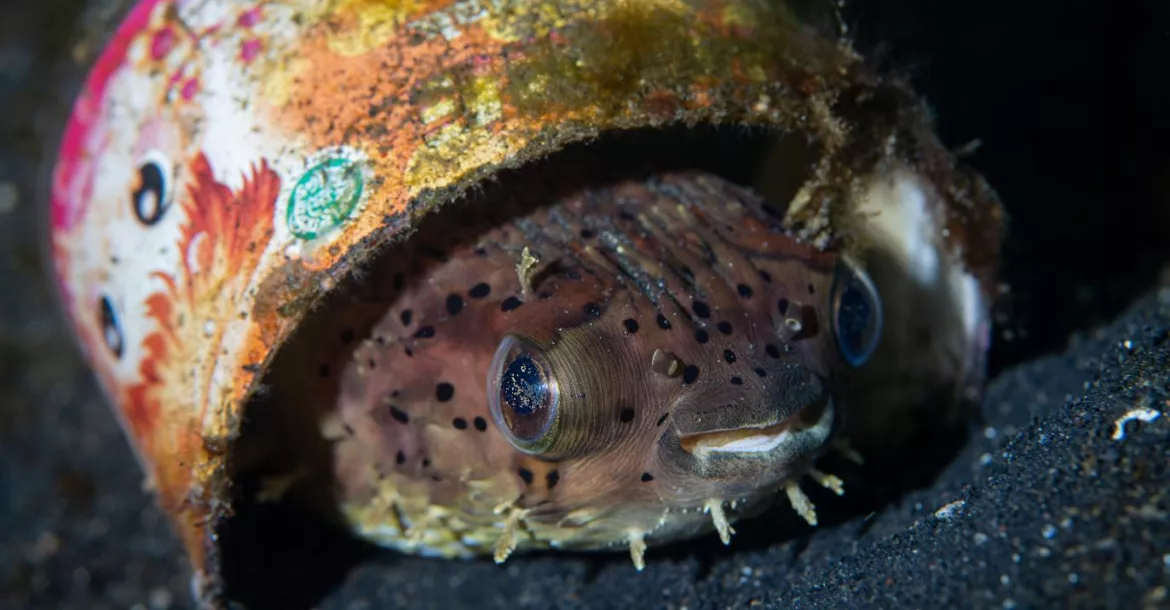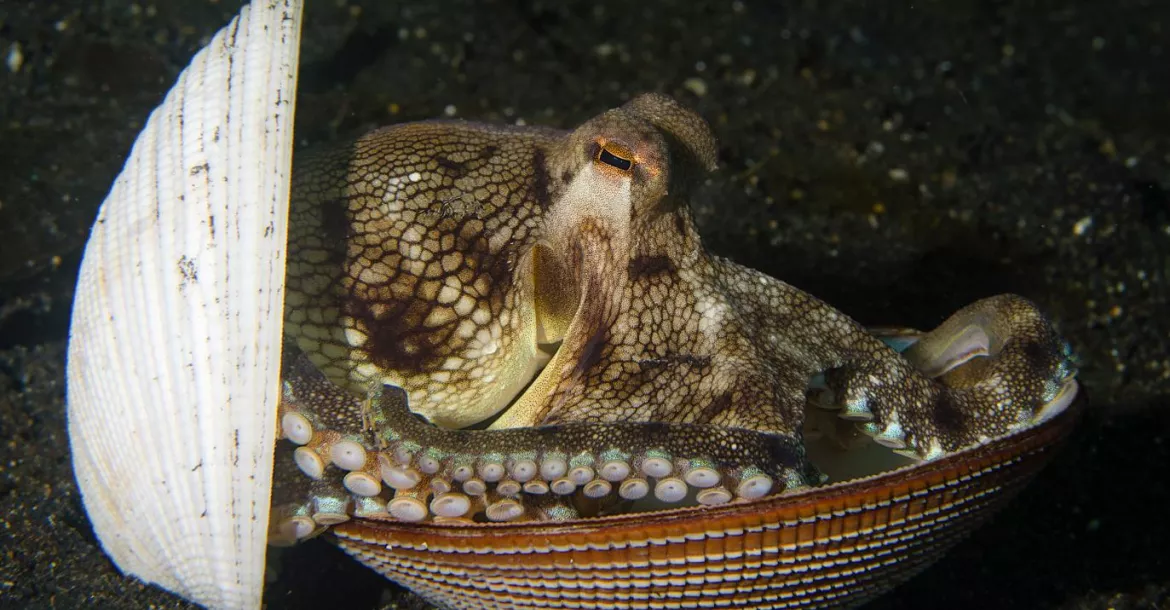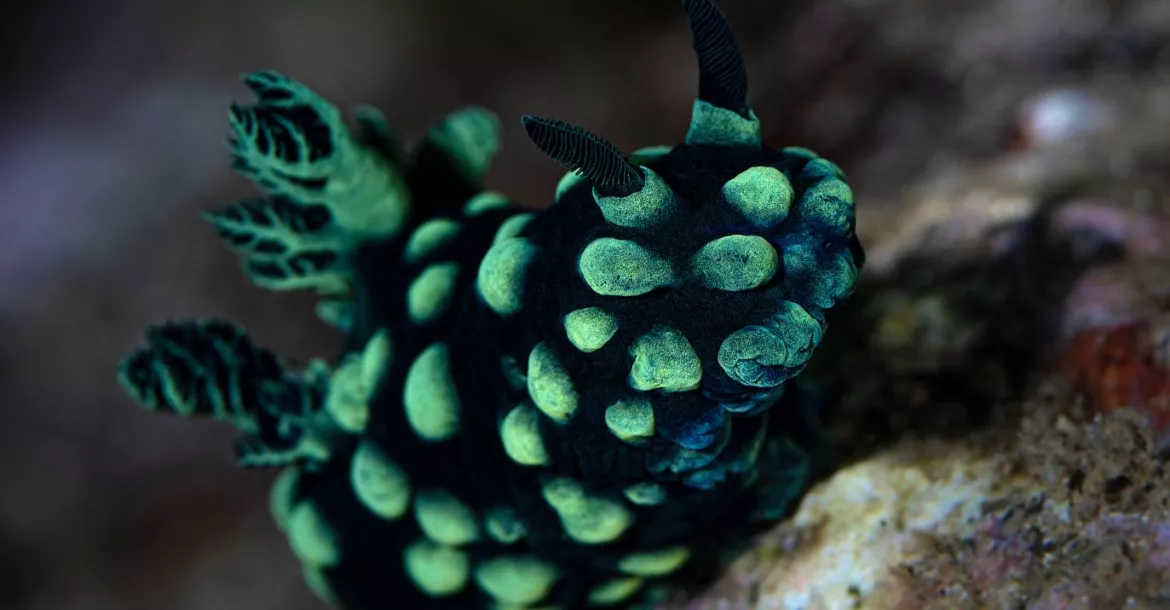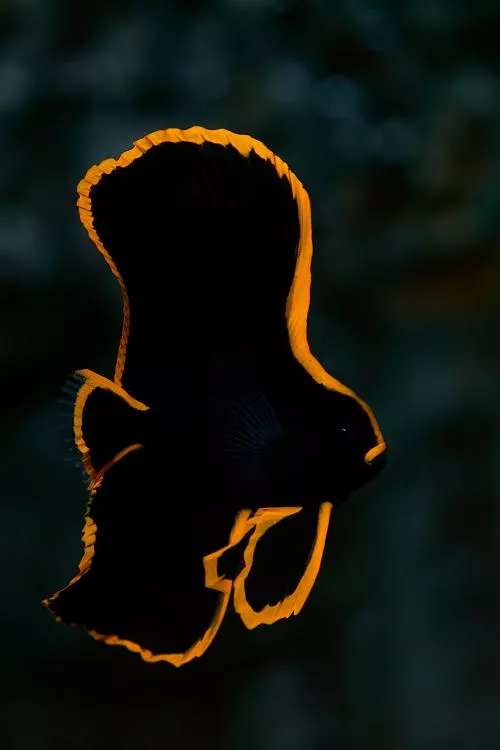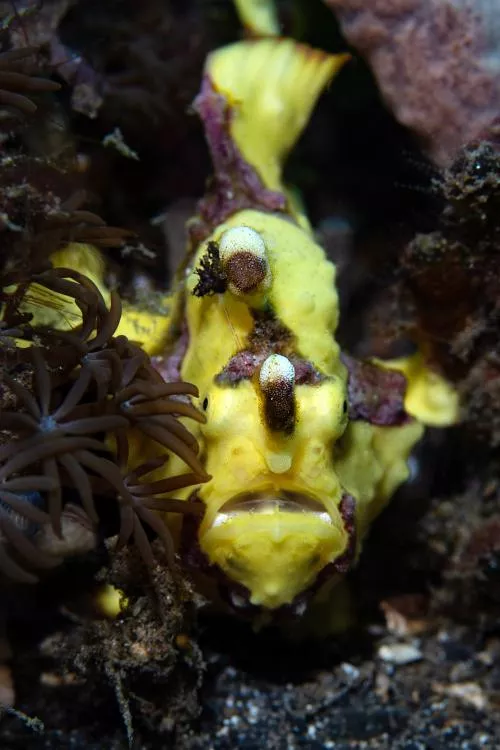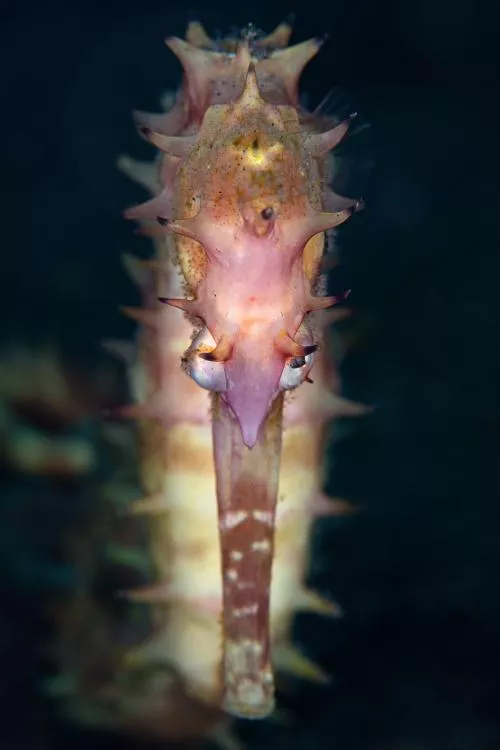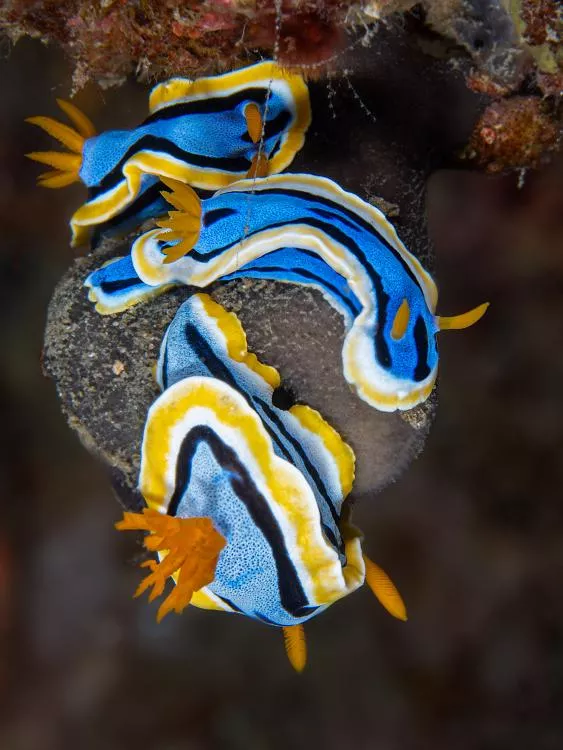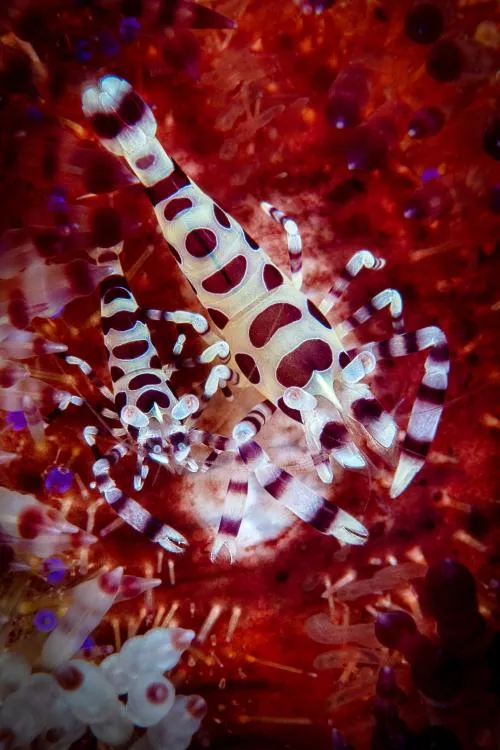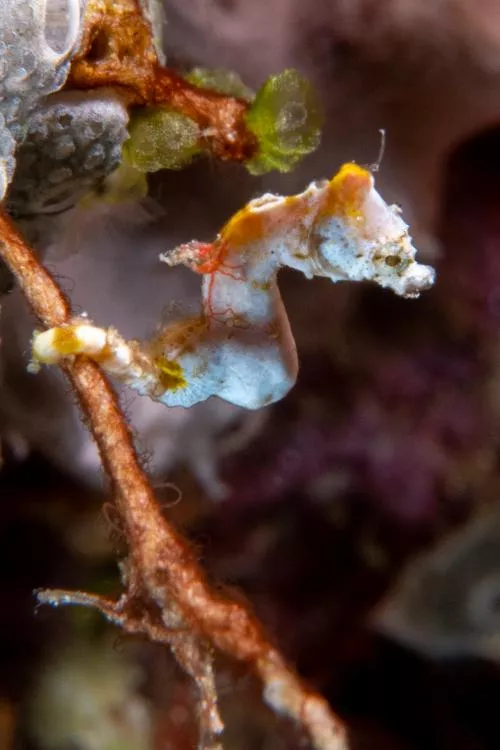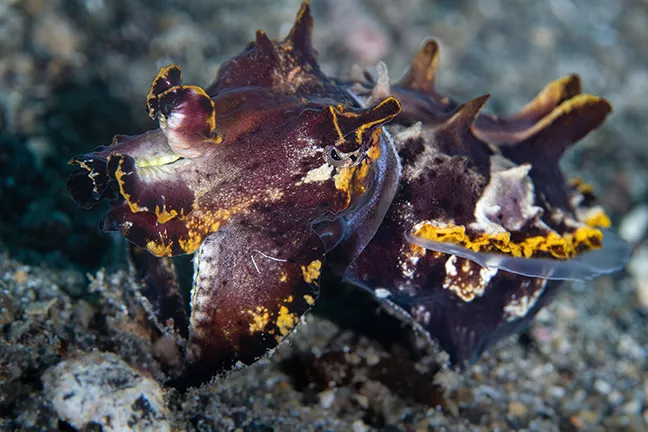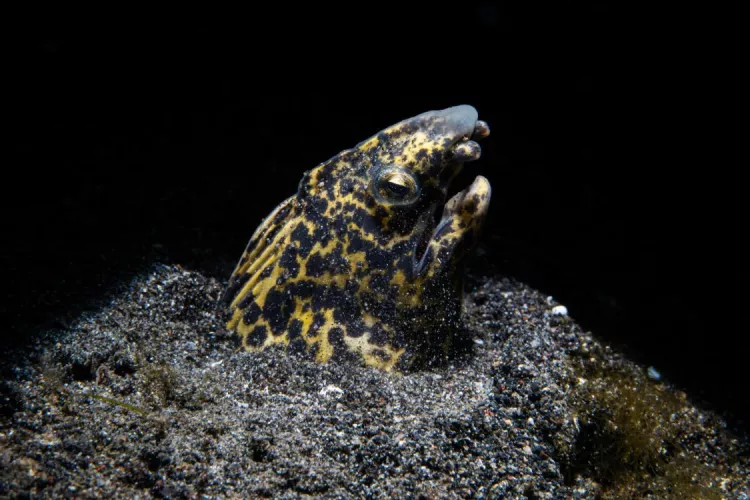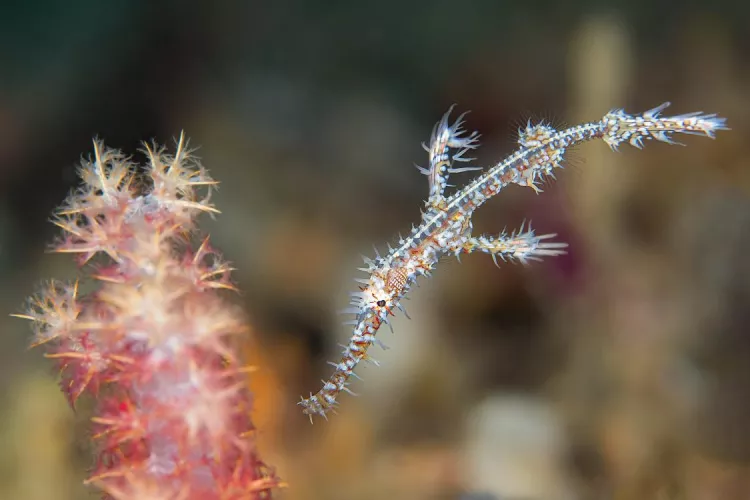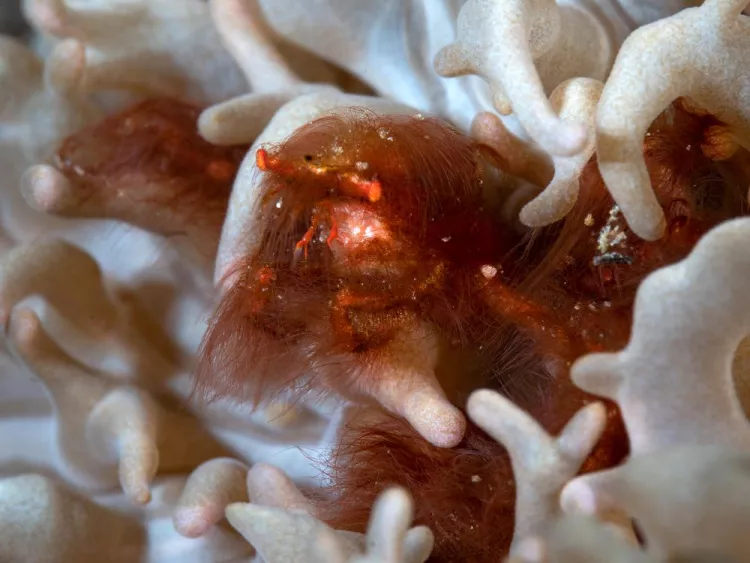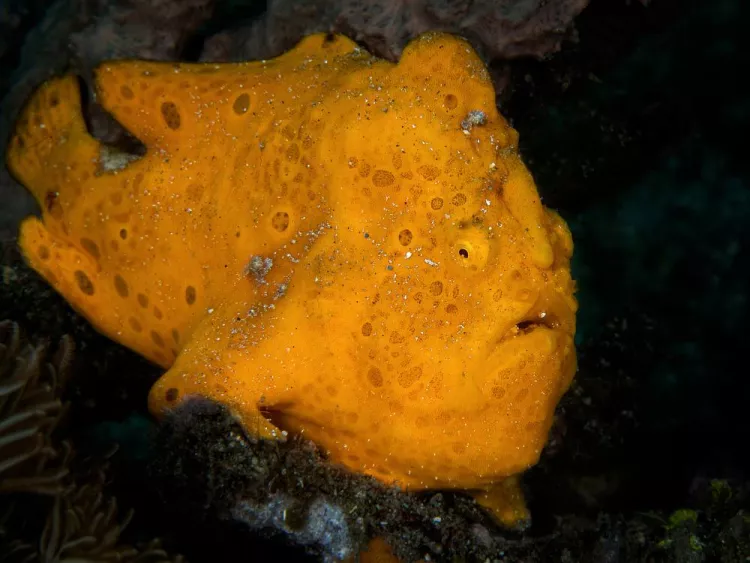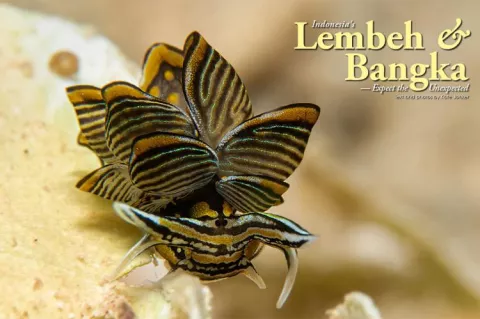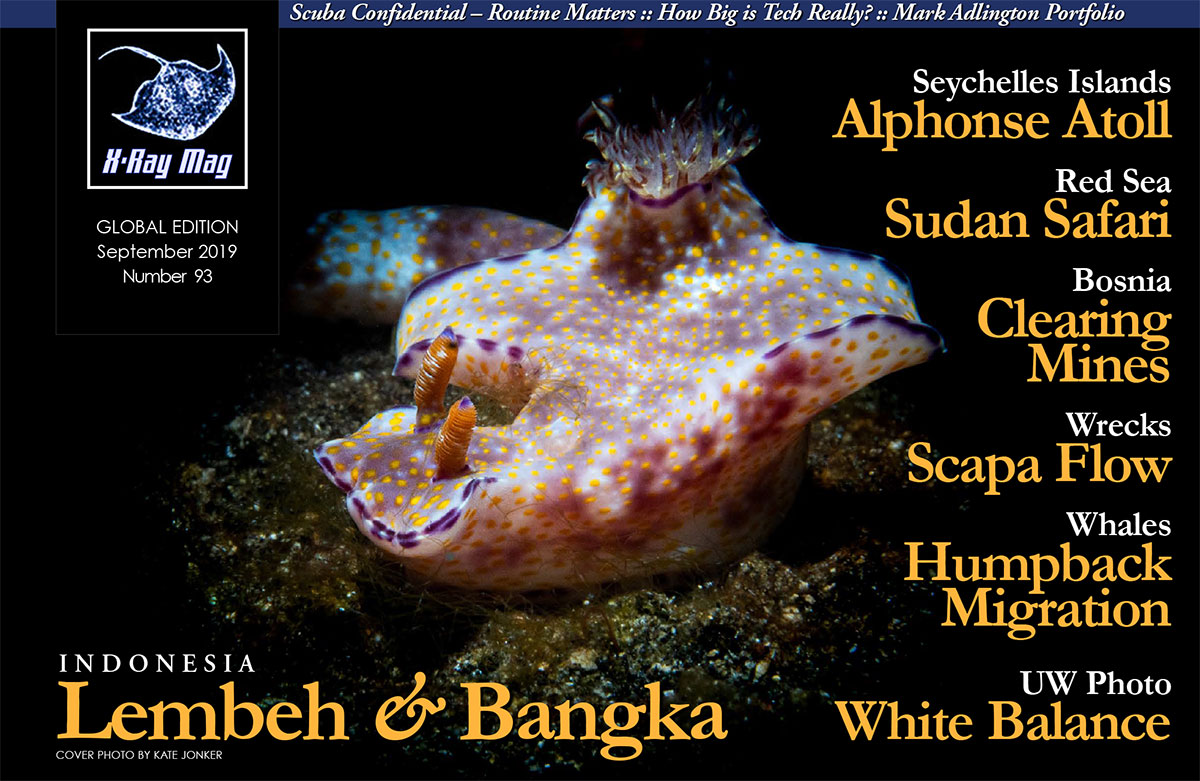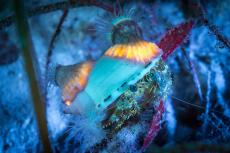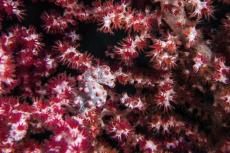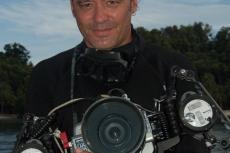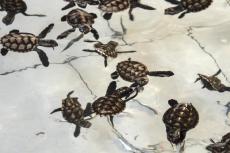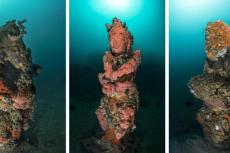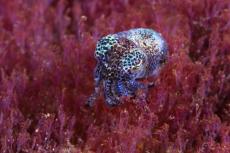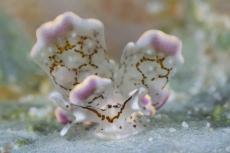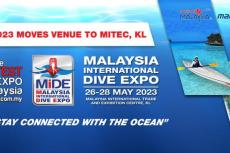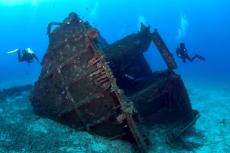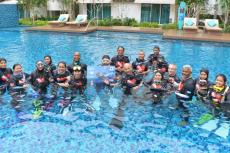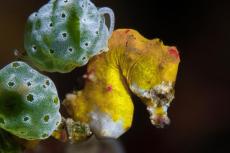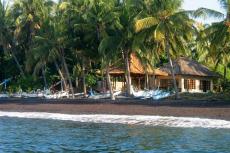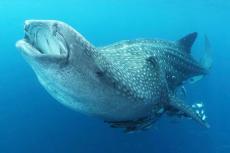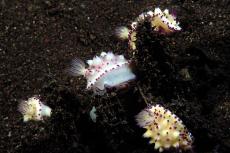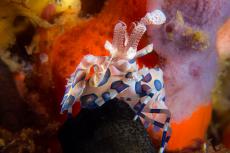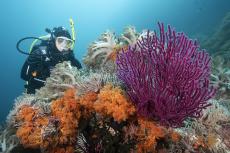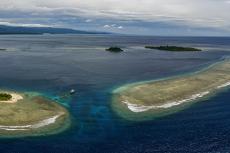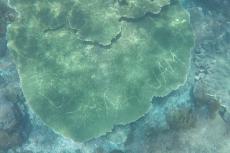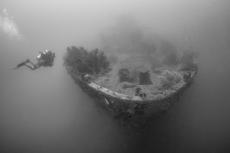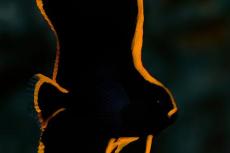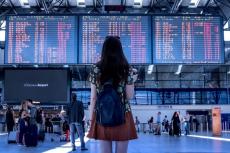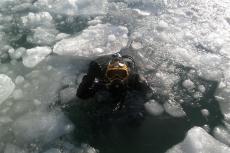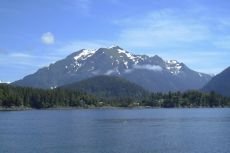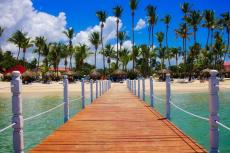Ting-ting-ting-ting-ting-ting-ting! Someone, somewhere, had found something really exciting! One of the dive guides was tapping frantically on the side of his cylinder with his metal pointer. Ting-ting-ting replied my dive guide Opo, only to receive more frantic tapping in response. My pulse rate upped a few more levels in anticipation of yet another exciting find. Following Opo and the frantic tinging up the dark sand slope, we finally found its source—one of the other dive guides had found a beautiful flamboyant cuttlefish.
Contributed by
Factfile
Kate Jonker is an underwater photographer and writer based in South Africa.
She teaches underwater photography, is a dive guide and dive boat skipper for Indigo Scuba in Gordon’s Bay and leads dive trips across the globe.
For more information, please visit: katejonker.com.
As we watched, the cuttlefish disappeared under a discarded coconut shell and reappeared. Opo motioned to me that it was laying eggs. We watched in awe and fascination but eventually left the cuttlefish to its maternal duties in search of other exotic creatures.
This was just the second day of diving Lembeh Strait and I was already starting to realise that despite everything I had read, Lembeh was not at all what I had expected.
Getting there
Lembeh Strait, more commonly known as just “Lembeh”, is a narrow stretch of water between the eastern coast of the Indonesian province of North Sulawesi and Lembeh Island.
Getting to Lembeh is relatively easy and usually involves a flight into Sam Ratulangi International Airport in Manado from one of the central hubs such as Singapore, Jakarta, Kuala Lumpur or Bali. Once in Manado, it’s a 90-minute drive to Lembeh and most resorts arrange a transfer from the airport, taking the stress out of trying to use taxis and public transport.
We had done exactly that and as we exited the airport terminal, we were met by a beaming gentleman called Johannes who loaded our suitcases into his air-conditioned van and handed us very welcome ice-cold bottles of water for the trip. Before long, we were travelling down well-maintained roads and enjoying incredible views of lush green hills and towering volcanoes whilst Johannes dodged the swarms of motorcycles and cars that came at us from every angle.
We reached a tiny and very busy jetty in the port town of Bitung where our luggage was loaded onto a boat with incredible efficiency for a ten-minute ride across the Lembeh Strait to our resort.
The resorts
There are many resorts in Lembeh, most with fantastic reviews on the Internet. This makes the decision of where to stay really difficult, especially as most resorts are similarly priced. As we had wanted to split our time between Lembeh and Bangka Island, we found it more convenient to choose a company that had resorts in both destinations.
The resorts are either situated on the mainland or on Lembeh Island, and most are located directly at the water’s edge. It can be quite hot and humid at water level and we were very happy to discover that our rooms, the restaurant, bar and swimming pool were perched at the top of a headland that always seemed to be cooled by a gentle breeze. We did have to climb a fair number of steps after diving or working in the camera room, but this was a small price to pay for the lovely cool air and beautiful views we had from our rooms and the public areas.
The diving
The diving in Lembeh is done from purpose-built motorised wooden boats, which have two or more outboard motors on the back and are hand-steered by the captain who sits next to the motors.
The boats are large and spacious with a small open deck in the front of the boat, a covered area with cushioned benches and overhead stowage areas in the main section and a toilet at the back of the boat.
We had booked three dives a day and the usual routine was to leave the resort at 08:00 and do two dives in the morning with a surface interval between dives. We would then return to the resort for lunch at noon and go out again for a third dive at 2.30 p.m.
When we checked into the resort, we were allocated plastic crates with our names on for all our dive gear. From that moment on, the incredibly efficient and kind staff kitted up our gear for us, ensured it was on the boat every morning and that there were extra cylinders, which they changed for us, ready for our second morning dives. We were offered tea, coffee, water, fresh fruit and cookies between dives and there were even beautifully scented towels with our names on for us to use whilst on the boat.
As this was the first time our little group had dived in Lembeh, there was great excitement as we climbed aboard for our first dives. There were six divers on the boat with three dive guides between us and whilst the crew was getting the boat ready to leave, we donned our wetsuits and booties. The boat left shore and we headed across Lembeh Strait to the mainland. Within ten minutes, we were slowing down alongside a partly sunken wreck and a huge old steel barge. “Welcome to Police Pier,” announced our dive guide Opo.
Opo gave us our pre-dive briefing and split us into three groups. We kitted up and waited for the go-ahead to back-roll into the water. As I looked down into the water, I was amazed. The water was clear and blue, and not the dirty, dingy green I had read about. I fell back into the water and looked down. Where was the trash I had heard so much about? As I descended to the seabed below, I felt as though I was dropping into someone’s untidy backyard. Poles, planks and ropes littered the coarse, rubbly dark sand, but I saw none of the plastic rubbish I had expected.
Rubble slopes
Before I had the chance to turn on my camera and strobes, I saw a bright yellow creature staring up at me. It was a small frogfish hiding amongst the marine life and dark stone rubble. I took a few photos and left it to the rest of the photographers.
Two metres on, I found a black crocodilefish with blue eyes resting beneath a wooden beam. As I started taking its photo, one of the dive guides nudged my arm and pointed to what looked like an old rag swaying gently to and fro. Upon closer inspection, I realised I was looking at a paddle-flap scorpionfish—one of the creatures I had always wanted to see. As I was taking a few shots of it, I saw a googly-eyed peacock mantis shrimp watching with great interest. It amiably let me take its photo before turning around and scuttling away.
At this stage I was suffering from severe sensory overload and took a moment to relax and take in my surroundings. I was amazed at the variety of colourful reef fish flitting around this untidy garden. Wrasse, anemonefish, juvenile batfish and fish I had never seen before were absolutely undisturbed by our bubbly intrusion. All too soon, I realised it was time to ascend. Just as I was about to start my safety stop, one of the dive guides came up to me and wrote “juvenile pinnate batfish” on his slate. When I gestured to him that my dive was over, he patted me on the head and swam off.
Getting back on board after a dive was very easy and simply required removing one’s fins and handing them to a crew member and climbing up a sturdy wooden ladder.
Sandy slopes and coral gardens
After an hour-long safety stop, we found ourselves descending yet again into beautiful blue water. This time, the dive was at a site called Critter Hunt, which was a steep slope of coarse light-coloured sand. We made our way down to about 19m and slowly followed the slope to a shallower depth. We did not need to hunt very hard as critter after critter popped out at us—from beautiful ornate ghost pipefish, tiny red hairy shrimp, a red scorpionfish that was no larger than my thumb, a huge yellow and green Tambja nudibranch and a minute orange Thecacera pacifica nudibranch known as “Pikachu.” We finished our dive on a lovely coral reef before having to return to the boat. What an incredibly beautiful dive!
After our second dive, it was back to the resort for a delicious buffet lunch of very tasty Indonesian cuisine and a quick change over of camera batteries before climbing back onto the boat for our third dive of the day.
We were all very excited to hear that we were going to visit the famous dive site known as Hair Ball for our first real “muck dive” of the trip.
Muck diving
As we descended into a moonscape of fine black sand, I was again taken aback by how little rubbish there was. I had really expected muck diving to be all about digging amongst plastic bags, discarded babies’ nappies, plastic bottles and other rubbish in search of critters. At Hair Ball, we did see the odd discarded shoe and a few empty tin cans and bottles, but not nearly the amount I had expected.
We followed our dive guides down to about 17m, stopping along the way to photograph a coconut octopus possessively guarding its shells and a small white frogfish perched on a white algae-covered sponge. I was incredibly excited to see a snake eel poking its head out of the sand and a crazy-looking Ambon scorpionfish with algae hanging from its appendages. A shy-looking porcupine pufferfish hid in a tin can, its eyes perfectly matching the eyes on the label on the side of the tin. A lone remora swam alongside us looking for an unsuspecting diver to latch on to and a beautiful spiny seahorse clung to an orange sponge. Soon after that, I spotted one of the hairy frogfish after which the dive site is named.
As we headed back up the slope to our boat, I stopped in amazement as I found myself looking at a sargassum fish hiding amongst some seagrass. This was a creature I had always hoped to see! I was able to take a few photos of it as it rested in the sand before it suddenly launched itself at me and chased me down the slope. No matter which way I turned, this feisty little fish kept on chasing me.
Eventually, the sargassum fish came to rest on the sand once more. I had been so busy photographing it as I beat a hasty retreat down the slope that I had not noticed a diver with a very large video camera filming the entire episode. So, someone out there has very funny footage of a big photographer being chased by a tiny fish!
And so ended our first day in Lembeh.
As I reviewed my photos that night and thought back on the dives we had already done, I realised how different Lembeh was to what I had expected. I was very keen to uncover more of the surprises Lembeh had in store for us!
Over the following five days, we explored 15 more dive sites, all of which were incredibly diverse, not only in topography and bottom composition, but in the marine life found at each site.
Sites included Arena Besar and Sarena Patah, with steep, sandy slopes and coral gardens in the shallows; Magic Rock and Makawidey, with colourful coral gardens; Trikora, Bianca and Police Pier, which were rubble dives with discarded pipes, poles, wood and rope; and Tike 3, Rodjos and Hair Ball, which were muck dives with dark, silty sand.
After six nights and 17 dives in Lembeh Strait, we waved goodbye to our Lembeh friends as the resort’s speedboat whisked us across the Strait for the last time. Our luggage and dive gear were loaded into a van, and before long, we were driving through the bustling streets of Bitung, on our way to the northern coast of North Sulawesi where we would board another boat for Bangka Island.
We had been told that the trip would take us about an hour and a half, but with the amount of traffic on the roads, the trip took us almost three hours. By the time we reached the beautiful island of Bangka, the sun was starting to set over the sea. It was absolutely picture perfect!
Bangka Island
We were greeted with warm welcomes and enjoyed refreshing drinks of coconut water straight out of young coconuts. As we completed the required waivers and documents, the manager Thomas told us about the resort, which had only opened the previous October. It was cleverly built around a central public area comprising a huge, open-air restaurant, bar and lounge area, camera room and sparkling rim-flow pool. No matter where you were in the small resort, whether on the deck of your lovely wooden chalet or in the pool, beautiful views across the stretch of water between Bangka Island and the mainland greeted you.
The diving procedure was the same here as it was in Lembeh, with the same type of boats and the same excellent staff service. As there was a large and beautiful house reef right in front of the resort, a long cement jetty had been built, enabling us to board the boats out beyond the reef.
Tanjung Usi 1. Our first dive was at a dive site called Tanjung Usi 1. This time, there were seven guests and three dive guides. We had wanted to visit Bangka Island to dive the beautiful reefs we had heard about. As soon as I rolled back, I realised we had made the right decision. Below us sprawled a sloping coral reef covered in soft corals and cloaked in schools of beautiful reef fish and sprinkled with a confetti of colourful nudibranchs. Tiny pygmy seahorses hung out on the sea fans and octopuses prowled the nooks and crannies in search of food.
Yellow Coco 1. For our second dive, we crossed to the mainland to do some muck diving at a site called Yellow Coco 1. One of the highlights of this dive site was a hot spring of fresh water that flowed from beneath the sand at about 20m. The seabed that surrounded it looked like a mini-oasis, with crinoids, sponges, soft corals, cuttlefish, nudibranchs and frogfish all making their homes here. It was fascinating to see how the fresh water shimmered as it flowed from the ground into the salt water and how the marine life seemed to thrive around this little warm spot.
Although the many colourful reefs with fantastic topography provided excellent wide-angle opportunities in Bangka, I decided to forgo the use of my fisheye lens and kept to my macro lens for the remainder of the trip instead. Our incredible dive guide, Yap, continued to find the most amazing critters that we had not found in Lembeh—from boxer crabs, Pontoh’s pygmy seahorses, the tiger butterfly nudibranch Cyerce nigra, to seamoths, weedy scorpionfish and even mandarinfish.
We were really glad we had decided to explore this little gem of North Sulawesi!
All too soon, our holiday came to an end and we made one final trip across the ocean to mainland North Sulawesi. The trip had been full of surprises and incredible experiences. Diving in Lembeh was not what I had expected. The trash, plastic and rubbish I had expected to see was not there. I had heard the villagers had made huge efforts to clear away rubbish from the beaches and perhaps this was why. I had expected the water to be dark and dirty with very low visibility, but we had experienced clear, blue waters on almost every dive. I had not expected to see much coral or colourful reefs in Lembeh, but only a third of our dives had been on dark, silty muck. I had also expected to see lots of ugly, drab creatures and had been surprised to see beautiful nudibranchs and reef fish on every dive. My advice to anyone visiting this beautiful part of the world—expect the unexpected!
Tips
What to wear
We visited at the beginning of June and the water temperature ranged between 26°C and 28°C. As I tend to feel the cold quite easily, I wore a 5mm full-length wetsuit and a hoodie. Some divers wore 3mm wetsuits but started feeling chilly towards the end of their dives. I would recommend a full-length wetsuit to protect yourself from stings. I also wore booties (with open-heeled fins) to protect my feet from rock rubble and other sharp objects when wading out to the house reefs. Gloves are discouraged and not necessary.
Underwater photography
North Sulawesi offers incredible photo opportunities for underwater photographers at all levels of experience and camera types. The critters range in size from large (turtles and schools of fish), medium (giant frogfish) to tiny (super macro sized nudibranchs, shrimps, and Severn’s and Pontoh’s pygmy seahorses).
Compact camera users have the luxury of being able to add wet wide-angle lenses and magnifying diopters of varying strengths during dives, and owners of the Olympus TG cameras can use their fantastic microscope mode. I would definitely recommend adding one strobe to these systems in order to light up your subjects correctly. One strobe, positioned above your housing, will work wonders in lighting up critters very close to the port of your housing as well as lighting up larger marine life a little farther away, which your camera’s flash cannot reach.
Lenses to use
I found a 60mm macro was great for fish portraits and larger subjects such as frogfish, octopuses, larger seahorses, ghost pipefish, flamboyant cuttlefish and reef fish. Adding a magnifying wet diopter to a 60mm macro lens helps you to take pretty good shots of smaller seahorses, shrimps and nudibranchs. I often used a +12.5 diopter with my 60mm macro lens and found this really quite versatile.
Macro lenses of 100mm (Canon), 105 (Nikon) and 90mm (Sony mirrorless) are also fantastic for smaller subjects such as nudibranchs, small fish, shrimps and little crabs. They are also useful when photographing shy fish due to the longer working distance these lenses give you. Adding diopters to these macro lenses will bring you much closer to your subjects and magnify them to super macro proportions. I used a +15 diopter with my 90mm macro lens and captured some incredible super macro images.
I had taken my Tokina 10-17mm fisheye lens and mini-dome port along with me, but did not use them, despite my best intentions to get some close-focus wide-angle shots towards the end of the trip. There were still critters I wanted to find, and I was certain I would see them when I had the Tokina on. There is always next time...
Strobes
On most dives, I used two strobes and changed their positions according to the type of lighting I was after. This ranged from standard front lighting to side lighting to inward or back lighting. On some dives, I used one of the strobes for my snoot and the other for standard lighting by centring it above the top of my housing.
Muck diving with a camera
Not only was the black sand on muck dives fine and silty and easily kicked up, but if you put your hand down to steady yourself whilst taking photos, this stirred up the sand just as much. I found that using a frog-kick finning technique helped to prevent the sand from being kicked up and that a pointer was a great help. Word of warning, though—make sure you are not accidentally spearing any marine life before digging that pointer in!
As most of the creatures are literally on the sand, I found it virtually impossible to use my normal camera position of slightly below and tilting upwards, or holding my camera at eye level of my subjects. I have heard of divers digging their cameras into the sand to achieve the right angle, but I was not keen to disturb the seafloor or possibly scratch my port.
In order to stay camouflaged, most muck-dwelling critters (octopuses, hairy frogfish, cuttlefish, some nudibranchs, scorpionfish and pipefish) tend to be very drab. Photographers might therefore find muck diving less colourful than what they are used to.
Handling of cameras
Many resorts have dedicated camera rooms for underwater photographers, usually with individual workspaces that have strip lights, shelves and power points. Most also have compressed air hoses to dry cameras with. The rooms are usually air-conditioned, helping to prevent moist air entering your housing and steaming up the inside of your port during a dive. I liked being able to set up my camera the night before, leaving it in the camera room overnight and just doing my final checks before loading it onto the boat the next morning.
The dive guides are usually very keen to carry your camera and put it on the boat for you. I found that our guides knew exactly how to handle cameras and I was always grateful for their assistance.
The dive resorts we stayed with had big plastic crates filled with fresh water on the boats and the guides liked to put the cameras straight into these crates as soon as we boarded the boats in the morning. I have often heard that most leaks happen in the rinse tank, usually when someone drops their camera onto yours, and chose to keep my camera with me on the boat instead.
When entering the water, underwater photographers do a backward roll and then have their cameras passed down to them by one of the crew members. Before I entered the water, I made sure my camera was close by and reminded the crew where my camera was and to pass it to me. This was done with great care and worked very well. Upon surfacing after a dive, I would just pass up my camera to a crew member who would then put my camera into one of the rinse tanks. As they knew I was quite sensitive to this, they took great care to make sure there was no big camera next to mine.
Wish list
I think every diver has a wish list of critters they would like to see, and the dive guides love a challenge. I had done my research of what one could find in Lembeh and put together a wish list of what I would love to see for myself. For the first couple of days, I did not share this list with our guide and was soon able to tick off many of these creatures, but there were still a few I really wanted to see but had not. I shared my list of about 10 critters with our guide and told him I would love to see them but that he was under no pressure to find them as “this was the ocean and nothing is guaranteed.” He looked at the list with interest and even added some of his own.
Over the next few days, our combined search formed a strong bond between us, and we had a lot of fun on our dives. I would highly recommend giving your guide such a list, emphasising that if he finds them, that would be fantastic, but if not, no problem.
Bottom time and dive profiles
Depending on the resort, you might find that the dive guides allow you to dive for as long as your bottom time and air allows. In both Lembeh and Bangka, our dives averaged 60 to 80 minutes. Our dives were never cut short if other divers needed to surface, and a dive guide would stay with us until our dive was done. I am certain there would be limits on very shallow dives, as the boats do need to get back to the resort for lunch at noon.
Mandarinfish dives
One of the huge drawcards in Lembeh is the mandarinfish mating at sunset. Upon arrival, we discovered that each resort was allocated a certain night to do the “mandarinfish dive,” and we would not be there for our resort’s allocated night. If you want to see the mating mandarinfish, remember to check on this with your resort before you make your booking! ■

